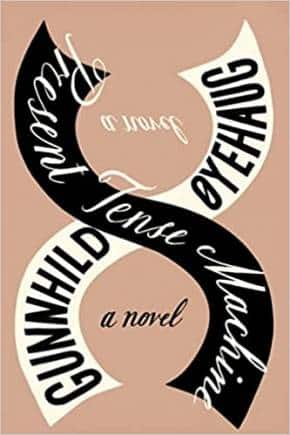



For many, the ongoing pandemic has altered and distorted the sense of time. Often, the bottom of the hourglass fills faster with sand; at other moments, the grains fall in slow motion. Stress, isolation and uncertainty warp our perception of the passage of days and can make us yearn for alternative realities or ways to explore the roads not taken.
The expansion and contraction of time, and the ways in which it branches forward and backwards, has long been a part of much speculative fiction. There are messages and characters from the future, journeys into the past, and rips in the fabric of the present. In this vein, Gunnhild Øyehaug’s new book, Present Tense Machine, translated from the Norwegian by Kari Dickson, presents a parallel universe of characters who are linked, yet unaware of each other’s existence.
 Present Tense Machine is notable for Øyehaug’s playful and almost teasing approach to a twin-track reality. This isn’t a work of hard SF, a portal fantasy, or a series of Hollywood-style apocalyptic events. Instead, it is grounded in the lived reality of a family in Bergen (a location that may be familiar to fans of Norwegian TV shows).
Present Tense Machine is notable for Øyehaug’s playful and almost teasing approach to a twin-track reality. This isn’t a work of hard SF, a portal fantasy, or a series of Hollywood-style apocalyptic events. Instead, it is grounded in the lived reality of a family in Bergen (a location that may be familiar to fans of Norwegian TV shows).
The main characters of the novel are Laura, in her 20s, and Anna, in her 40s. Laura lives with an Instagram-friendly pop-star and is expecting their first child; Anna, a writer and teacher obsessed with language and meaning, lives with her second husband and two teens. Under the veneer, however, Laura has “the disconcerting feeling that everything is double”, and Anna lives in what “feels like a parallel, secret life”.
This is because they do, in fact, live in different universes. Before their worlds diverged, Laura was Anna’s young daughter from her first marriage. The split that sent them on their separate ways occurred one afternoon years ago when Anna was outdoors reading a book and keeping an eye on Laura riding her tricycle on the lawn. In her mind’s eye, Anna misreads “trädgårdar”, the word for “garden”, as “tärdgård”, a nonsensical word. This transposition (“an r away from a t over toward a d”) causes a new world to open up, separating the two characters and reshuffling their memories.
“We know that it’s hard to believe,” says the narrator. “But that is in fact how it happened, and no other way.” This narrator’s voice is another marked feature of the book. It interjects, it interprets, and it sometimes comments on the process of writing itself: “Just as I wrote the word language there was a howl from the living room, it’s Kipp — I’ve perhaps forgotten to say that he’s my dog, and he’s standing by the door howling, he wants out. But I don’t have any dry socks, so he’ll have to wait.” What could, in other hands, become a mannered metafictional tic is here a deft and even endearing guide to the novel’s mechanics and concerns.
Present Tense Machine proceeds in sentences that are fluid and flexible, continuing onward in graceful arcs to capture an altered reality. As one character thinks, it’s as though “the whole universe had wiped something from its memory, and he was the only one left with the vague feeling that something was missing, that something wasn’t right…”
Language and its confusions are always on or below the surface. At one point, Anna wonders if everything is simply a gigantic metaphor. Without being overbearing, there are also reflections on Noam Chomsky’s universal grammar and the levels of irony in Chekhov’s short story, The Student. These are undercut by more impish comments: on another occasion, Anna is struck by the titular name of a street-sweeping device, but it turns out that its actual name isn’t Present Tense Machine but “Precise-n-Tidy Machine”.
Modifications on such themes are found throughout the novel. Appropriately enough, the 19th-century French composer Erik Satie’s piano piece, Vexations, plays a unifying role in both women’s lives. Considered one of the longest musical compositions, it comprises only three lines of music that are variations on the same theme. (In passing, the way that this is described in the novel brings to mind Raymond Queneau’s Exercises in Style, although Øyehaug’s work is in a completely different register.)
They say that in the beginning was the word, as the narrator of the novel often points out. In this spirited meditation on words, language, and reality, Øyehaug stretches concepts arising from the Tower of Babel almost to breaking point, to come up with a beguiling fictional construct of the many tenses of the present.
Discover the latest Business News, Sensex, and Nifty updates. Obtain Personal Finance insights, tax queries, and expert opinions on Moneycontrol or download the Moneycontrol App to stay updated!
Find the best of Al News in one place, specially curated for you every weekend.
Stay on top of the latest tech trends and biggest startup news.